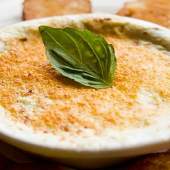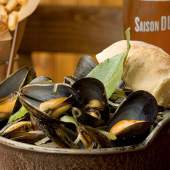Soup

“Only the pure in heart can make a good soup.”
— Ludwig van Beethoven
It’s that time of year — you slog home in darkness at the end of a cold day, and what tastes better than a nice big bowl of hot soup? It’s filling, warming, and nutritious, and every culture has at least one that they love.
How long has soup been a mainstay of our diet, and where did it originate? The name is French, from soupe, which means “broth” from the Latin suppa, or “bread soaked in broth.” Actually, while we’re at it, the word “restaurant” is also from the French, and it originally referred to soup that was sold on the streets sometime during the 16th century that was said to be energy “restoring.” Once an actual brick-and-mortar soup establishment was opened by a former street vendor shortly before the French Revolution, it was referred to as a “restaurant.” And the name stuck.
While there’s pretty strong evidence that soup in some form has been around since at least 20,000 BC, it didn’t really come into its own until someone came up with a cooking pot that could withstand very hot temperatures. Its predecessors, baskets and animal hides, were acceptable for cooking other foods, but did not work very well for liquids. (Just imagine the messy catastrophes.)
By the 1770s, soup and bisque recipes started showing up in cookbooks, and immigrants brought their country’s most popular soups with them to America (our eternal thanks to the Germans, for example, who popularized potato soup). Two hundred years before “The Soup Nazi” took New York City by storm in the television series Seinfeld (“No soup for you!”), a gentleman with the elaborate name of Jean Baptiste Gilbert Payplat dis Julien, who fled to America to escape the French Revolution, established himself in Boston as “The Prince of Soups” with his eatery The Restorator. The first recorded instance of an American cookbook devoted entirely to soups arrived on the scene in 1882: Soups and Soup Making by Emma Ewing.
There are two general categories of soups: thick soups that are augmented with cream, eggs, flour, butter, squash, corn starch, and/or other ingredients; and clear soups (also known as consommé or bouillon). To these mixtures are sometimes added rice, noodles, grains, vegetables, beans, lentils, meats, and almost anything else you might have that isn’t nailed down (if you put enough in it, it will qualify as a stew). Soup is nothing if not versatile, and almost anyone can make it.
So, when did condensed canned soup make its appearance on the culinary landscape? You might not be surprised to learn that it was a chemist with the Campbell Soup Company, a Dr. John T. Dorrance, who conceived it in 1897. Wives and mothers loved it — all they needed to do was add water, heat, and serve with crackers or a sandwich. Or they used the condensed soup as a base for their own homemade variety, or as the basis for other recipes (Cream of Mushroom soup in Green Bean Casserole, anyone?). There are also dried soups that work very well in recipes (French onion and spinach dips in particular). And of course, there’s cold soup as well (the refreshing tomato-based gazpacho).
Some soup stats:
- The first specific soup variety on record, from about 6,000 BC, was hippopotamus soup. No word on how it tasted.
- Each year, Americans collectively consume more than 10 billion bowls of soup.
- The 10 most popular soups in America, according to Campbell’s Soup Company, are, in order: tomato, chicken noodle, cream of chicken, cream of mushroom, chicken with rice, bean with bacon, New England clam chowder, vegetable beef, chunky chicken with dumplings, and chicken & stars.
- Speaking of clam chowder, where did oyster crackers, its customary accompaniment, come from? There are two claimants for the invention of these bite-sized round crackers: Westminster Cracker Company in New England in 1828 and New Jersey’s Adam Exton Cracker Bakery in 1847. Why are they called “oyster” crackers? Because they were often included in oyster stews…and probably also because they look a bit like oysters. (Hint: they’re great with chili, too.)
- It is rumored that clear soup came about at the suggestion of a narcissistic French king who liked to see his reflection in the bowl.
- The spoon was invented at the French court, to keep the gentry from dribbling soup onto their elaborate lace collars. Prior to that, they drank it straight from the bowl, which explains a lot.
- Frank Sinatra (whose favorite was chicken rice), Abraham Lincoln (who loved mock turtle soup), Elvis Presley (potato cheese soup with onion rings), and Andy Warhol were all fans — Warhol said that he got the idea for his favorite Pop-Art work, “32 Campbell’s Soup Cans” (1962), from his daily lunch.
- During the Great Depression, soup kitchens were set up in cities to feed the poor. They were sardonically referred to as Hoover Cafes, named for the unfortunate occupant of the White House at the time, whom people blamed for their troubles.
Start your meal with soup…or make it your entire meal with bread, crackers, or a sandwich. It’s terrific either way!





